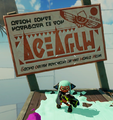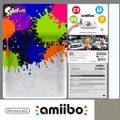Language in the Splatoon series: Difference between revisions
mNo edit summary |
(Added detailed description about the way fictitious scripts are handled in the game) |
||
| Line 10: | Line 10: | ||
==Appearance== | ==Appearance== | ||
Across the games, numerous fictitious scripts used in the games world can be observed, ranging from unique glyphs to ones resembling human scripts like [[wikipedia:Japanese writing system|Japanese]], [[wikipedia:Arabic script|Arabic]] and [[wikipedia:Cyrillic script|Cyrillic]]. Speech-wise, Inkling speech does not seem to possess any deeper meaning that would correspond to the species' written language, aside from certain voice clips resembling Japanese or English words at times. Ultimately, it is indecipherable high-pitched gurgling. | |||
===Scripts=== | |||
It has been discovered that many of the fictitous scripts used throughout the games are decipherable, however the way this is achieved may be counterintuitive. Scripts that are decipherable have an internal order that has the fictitious letters correspond to the letters of the Latin alphabet; we refer to this as the “true order”. | |||
However, this order is not the only way in which the developers apply the script to in-world text. Another method used is to forgo the true order and pick characters based on how closely they resemble the latin letters, while this resemblance is not found in the script's true order; we will call this “mimicking order”. | |||
An example would be the cover artwork from Turquoise October in Splatoon 1, where the Square Script is used in a way to mimic the word “OCTO”, even though this is not the actual meaning of the letters, based on what has been deciphered from texts using the true order of the script. The twenty-fourth Sunken Scroll from Splatoon 2 is an example of the same script being used in its true order, which doesn’t resemble what the text would look like in the Latin alphabet. Any situation in which fictitious letters seem to resemble an English word, will most likely not reflect the true meaning of the script, and should not be used as a basis for deciphering work. | |||
Furthermore, there are also instances where fictitious letters are being used that are not part of a complete script, which is often the case with in-game company logos for example. If the letters used in these situations do not show up anywhere else, it is likely not a real script and was only designed for the logo specifically. | |||
There are also situations in which scripts are used neither in the mimicking, nor the true order, but in a scrambled manner, in which characters are rotated and flipped to display gibberish text. Observing text with characters rotated and flipped in ways we know should not exist going off of the true order, this text is to be considered meaningless as well. | |||
Lastly, the glyphs that resemble ones from human languages like the Japanse or Arabic are not known to possess any internal order, other than what real-life glyphs they are mimicking. | |||
Focusing on the usage of the script’s true orders from now, there are also different languages in which the scripts may be written in. While most of the time the developers write in English, there are also occurrences where the script is being used to write [[wikipedia:Romanization of Japanese|romanized Japanese]]. | |||
{| class="wikitable sitecolor-generic" | {| class="wikitable sitecolor-generic" | ||
!Script | !Script | ||
Revision as of 22:09, 8 June 2022
THE INKLING LANGUAGE PAGE NEEDS A MASSIVE OVERHAUL. This is where I (and anyone else is welcome) will mess around and fix it. Template:Todo

Can you help us get it done?

The name(s) presented could be conjectural.
Inkling,[1] also referred to as squid language,[2] is the language in which Inklings in the Splatoon series communicate. While individual letters, words, and the occasional phrase are often similar to real-life languages, Inkling as a whole has been confirmed by Splatoon developers to be almost entirely random.[3] However, it has been discovered that there are several scripts which are decipherable.
Inkling is also sometimes referred to by fans as "Inklish", which is a combination of the words "English" and "Inkling".
Appearance
Across the games, numerous fictitious scripts used in the games world can be observed, ranging from unique glyphs to ones resembling human scripts like Japanese, Arabic and Cyrillic. Speech-wise, Inkling speech does not seem to possess any deeper meaning that would correspond to the species' written language, aside from certain voice clips resembling Japanese or English words at times. Ultimately, it is indecipherable high-pitched gurgling.
Scripts
It has been discovered that many of the fictitous scripts used throughout the games are decipherable, however the way this is achieved may be counterintuitive. Scripts that are decipherable have an internal order that has the fictitious letters correspond to the letters of the Latin alphabet; we refer to this as the “true order”. However, this order is not the only way in which the developers apply the script to in-world text. Another method used is to forgo the true order and pick characters based on how closely they resemble the latin letters, while this resemblance is not found in the script's true order; we will call this “mimicking order”.
An example would be the cover artwork from Turquoise October in Splatoon 1, where the Square Script is used in a way to mimic the word “OCTO”, even though this is not the actual meaning of the letters, based on what has been deciphered from texts using the true order of the script. The twenty-fourth Sunken Scroll from Splatoon 2 is an example of the same script being used in its true order, which doesn’t resemble what the text would look like in the Latin alphabet. Any situation in which fictitious letters seem to resemble an English word, will most likely not reflect the true meaning of the script, and should not be used as a basis for deciphering work. Furthermore, there are also instances where fictitious letters are being used that are not part of a complete script, which is often the case with in-game company logos for example. If the letters used in these situations do not show up anywhere else, it is likely not a real script and was only designed for the logo specifically.
There are also situations in which scripts are used neither in the mimicking, nor the true order, but in a scrambled manner, in which characters are rotated and flipped to display gibberish text. Observing text with characters rotated and flipped in ways we know should not exist going off of the true order, this text is to be considered meaningless as well. Lastly, the glyphs that resemble ones from human languages like the Japanse or Arabic are not known to possess any internal order, other than what real-life glyphs they are mimicking.
Focusing on the usage of the script’s true orders from now, there are also different languages in which the scripts may be written in. While most of the time the developers write in English, there are also occurrences where the script is being used to write romanized Japanese.
| Script | Description |
|---|---|
 |
This "Bold" script resembles the typeface primarily used in the original Splatoon game for dialogue. It appears in both games and is widely used on e.g clothes, weapons. Examples of this script can be seen on the |
 |
This "Square" script appears in Splatoon, Splatoon 2 and in promotional material for Splatoon 3. This script is widely used for various different applications e.g. on weapons, clothes, in Sunken Scrolls, buildings, and it's often used for large bodies of text such as in the descriptions of Museum d'Alfonsino and Shellendorf Institute. The Sunken Scrolls reveal it's also the text used in Inkling social media, and it's also used in Octarian weapon blueprints. It's also present throughout the underground facility in Octo Expansion. This wide application suggests it may be language understood by several species. |
 |
This "Round" script appears in Splatoon and Splatoon 2. It is mostly used on buildings, signs and posters. |
| image | "Bubble" script |
| image | "Runic" script |
| image | "Serif" script |
| image | "Halfmoon" script |
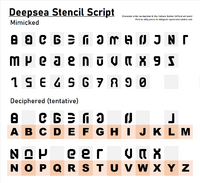 |
This "Deepsea Stencil" script made its debut in Octo Expansion and is one of most frequently used scripts there. |
| image | Deespea Block |
Readable words
Some Inkling words are clearly readable as English or Japanese words.
Bold Script
explain: bold script is often used to mimic words. should this be in all one table with a column for "internal order or mimicry"? or two tables? maybe 2 talbes for bold with how numerous the examples are
| Image | Meaning | Additional Information |
|---|---|---|
 |
TOKI MEKI BOMB☆RUSH | The logo seen on the Squid Sisters' trucks when Callie performs Bomb Rush Blush. Refers to the Japanese name of the song, トキメキ☆ボムラッシュ Tokimeki☆Bomu Rasshu |
Square Script
| Image | Meaning | Additional Information |
|---|---|---|
 |
www.seaocolors.com | Located at the bottom of the poster. The remaining square script text is gibberish. |
Round Script
explain how round script is used according to internal order with little inconsistency
| Image | Meaning | Additional Information |
|---|---|---|
 |
ON AIR | From the studio where Inkopolis News is filmed. |
 |
LIVE, niconicochokaici, SHIOKARAZ | The "niconicochokaici" is in small text at the top, and alludes to "niconico chokaigi". "LIVE" is at the top part of the poster. "SHIOKARAZ" Refers to the Japanese name of the Squid Sisters. |
| File:S2 UFO Catcher Text.jpg | UFO CATCHER | From the Arcade Machine directly next to where the player can access Squid Beatz 2 in Inkopolis Square. The text underneath it appears to not be Round Script, but instead seems to be attempting to mimic Japanese. |
Bubble Script
| Image | Meaning | Additional Information |
|---|---|---|
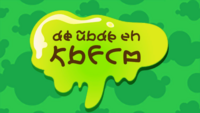 |
SU MISO AE NIGHT | The logo seen on the Squid Sisters' trucks when Marie performs Tide Goes Out. Refers to the Japanese name of the song, スミソアエの夜 Sumisoae no Yoru, instead using the English translation of yoru, "night." |
Runic Script
Serif Script
Halfmoon Script
Deepsea Stencil Script
Unlike the previous scripts, Deepsea stencil does not consistently follow its internal order and is almost entirely used to mimic words.
| Image | Meaning | Additional Information |
|---|---|---|
 |
Mission Clear, Number 10008 | Seen in the text surrounding the "TEST PASSED!" text. |
Deepsea Block Script
Like Deepsea Stencil, Deepsea Block does not consistently follow its internal order and is almost entirely used to mimic words.
Other examples of readable scripts
The following examples show text that is designed to be readable by the player and do not fall under any of the above listed scripts.
| Image | Description |
|---|---|
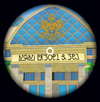 |
The sign at Mahi-Mahi Resort, saying "Mahi-Mahi Resort and Spa". |

|
The Squid Sisters' logo says "Pitz 2", which is similar to "Peace 2'. |
| This sign in Moray Towers says 'Exit'. | |
| File:Nintendo sign.jpg | This reads 'Nintendo'. This is found in Ancho-V Games. |
| The banner at Shellendorf Institute resembles the letters "Tho Davon Mujum," which is similar to the stage's name in Japanese, "Devon Oceanographic Museum". | |
| File:Squid Beatz 2 title.jpg | Squid Beatz 2's logo resembles the words "Ika Radio 2", translating to "Squid Radio 2". |

|
The logo of Wahoo World seems to spell out "SMESHI WORLD", which is the stage's name in Japanese. |
| File:Information-desk-WahooWorld.jpeg | The sign seems to spell "information" in English. This is located in Wahoo World. |
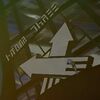
|
The sign on the Unnamed Battle Lobby Tower in Splatoon 3. The text after SquidForce's logo seems to spell "ThREE" in English. |
 |
Using the cipher fans have found for the "Round" font, the top part reads "niconicochokaici", which is aluding to "niconico chokaigi". Behind the Squid Sisters reads "live". The bold middle of the poster reads "shiokaraz" with the cipher, which alludes to the Japanese name of the Squid Sisters "Sea'O Colors". The rest of the poster features the "Square" font and at the very bottom, using the cipher, it reads "www.seaocolors.com". |
- Octopus-style posters near the Deepsea Metro read "Octavi", similar to "octavo" which means "eighth", along with a faded picture of an octopus. It is possibly a movie poster.
- MakoMart posters have oranges on them and read "StVy Fresh", which is very similar to "Stay Fresh". This implies that the slogan was adopted as a food motto as well, also a pun for the real-life term fresh fruit.
Brands
| Image | Description |
|---|---|

|
Ammo Knights' logo loosely resembles "KNBI ARMS", a shortened form of Kanburi Arms, the Japanese name of Ammo Knights. |

|
The Forge brand logo resembles the letters "Forリマ", which is similar to the brand's name in Japanese, フォーリマ (fōrima). |
| The Splash Mob brand logo resembles the letters "GiMN", which is similar to the brand's name in Japanese, ジモン (jimon). Interestingly, Gimn is a Russian word, meaning "Anthem", "Canticle", "Carol" or "Hymn". | |

|
The Tentatek brand logo resembles the letters "AROME", which is the brand's name in Japanese, アロメ (arome). |

|
The Zink brand logo resembles the letters "IArOIC", which vaguely resembles the brand's name in Japanese, アイロニック (aironikku, i.e. "ironic"). |

|
The Enperry brand logo loosely resembles 大王イカ (daiō-ika), the Japanese name for the giant squid. |
Splatfest shirts
Nearly all Splatfest Tees have readable words. A few examples are listed here. For more images of Splatfest Tees, see Splatfest team tees from Splatoon and Splatfest team tees from Splatoon 2.
-
"Cat".
-
"Dog".
-
"Water Slide".
Decoding
There have been many attempts at decoding the Inkling language, and while it appears to be largely gibberish with instances of using glyphs to make words that resemble existing English and Japanese words, the usage of those glyphs have been inconsistent. Though there have been instances where certain scripts are used more consistently throughout the game and has allowed people to decode them when used as such.
Others believe that, since Nintendo has made previous languages with some translatable words before, such as the Hylian language from the Legend of Zelda series, it could be possible that Inkling can be translated.
Official lyrics for songs by Off the Hook and the Squid Sisters have been distributed with merchandise, such as albums and piano sheet music. An in-universe interview with Wet Floor also disclosed a couple of lines for the song Inkoming! that incorporate sounds resembling English words. Lyrics for Ebb & Flow (Octo) are also shown to incorporate the word "splatoon", albeit slightly deviated from how it is normally spelled in katakana.
Octoling language
The Octolings seem to have their own language seen in Octo Valley and Octo Canyon. It has many similarities to the Inkling language but seems to be in a more box-style font unlike the Inkling language, which can be in a variety of fonts. The Octoling language seems to have two dialects similar to Japanese: the normal Octolings make Inkling-esque sounds, while Octosnipers, Octocommanders and all varieties of Octotrooper make groaning sounds that mimic the noises Inklings and Octolings make when they take damage or are splatted. The noises Jellyfish make (Jelonzo and Jelfonzo, as other Jellyfish are never heard talking) seem to speak in the same "groaning" dialect, implying that some Jellyfish speak Octoling.
In the Japanese versions of both Splatoon games, Inklings talk in hiragana, and Octarians in katakana (along with a brainwashed Callie and Marina, occasionally; detailed in The Art of Splatoon 2). In Japanese media, a character's dialogue being written with katakana can also imply a foreign accent of some sort. Off the Hook's songs are bilingual, with both Pearl and Marina singing portions in Octoling. An Inkling's experience listening to them has been compared to Japanese people listening to English-language songs without an understanding of the language, but an appreciation of the melody.[4]
Audio
Gallery
-
An Inkling stands in front of a sign in the Inkling language
-
The back of amiibo box found in Inkopolis Plaza using the out-of-bounds glitch, mostly written in Inkling
-
Part one of glyphs of the Inkling language
-
Part two of glyphs of the Inkling language
-
Part three of glyphs of the Inklings language
-
The front of Inkopolis Tower's Battle Lobby is labelled in Inkling, along with the brand on the speakers
Names in other languages
See also
References
- ↑
 Jelfonzo - Play Nintendo
Jelfonzo - Play Nintendo
- ↑
 Splatoon 2 - Live Concert at Nintendo Live 2019 - Nintendo Switch (via closed captioning)
Splatoon 2 - Live Concert at Nintendo Live 2019 - Nintendo Switch (via closed captioning)
- ↑ Mynavi: 「Splatoon(スプラトゥーン)」のイカしたデザインのひみつ(後編) (3) 解読不可能? イカ語のひみつに迫る | マイナビニュース (Splatoon developer interview)
- ↑ Famitsu: イイダのパートはイカと異なる言語、サーモンランはシャケを鼓舞する変拍子。『スプラトゥーン2』サウンドに迫る、サントラインタビュー (Splatoon 2 composer interview)
Allowed user:Ardnin



